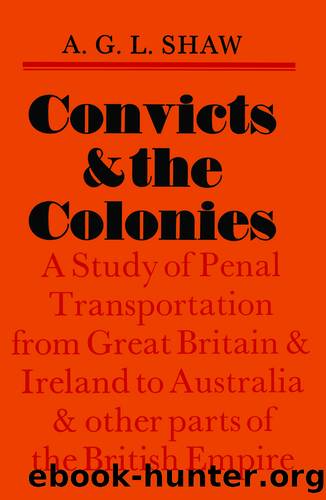Convicts And The Colonies by Shaw A G L

Author:Shaw, A G L [Shaw, A G L]
Language: eng
Format: epub
Tags: History, General
ISBN: 9780522862973
Google: kjeCwwEACAAJ
Publisher: Melbourne University Publishing
Published: 2013-02-01T03:07:01+00:00
In Van Diemenâs Land, Arthur had organized a mounted police force in 1826, during âthe heat of bushrangingâ. He deliberately filled it from âthe best conducted prisonersâ, who were âstimulated to exertion by the hope of a mitigation of their sentenceâ. He thought this provided a motive for their reformation and created âdistrust and disunion among the Prisoner populationâ, though their presence, like that of emancipists among the ordinary constables, lowered its standing. But the governor exercised closer control than in New South Wales, and in 1828 reorganized the whole force. He now divided the colony into nine police districtsâpreviously fiveâand put a stipendiary magistrate, with a force of convict mounted police, in charge of each.2
Even the governorâs critics admitted that this police system was an âexcellent piece of policyâ, and Arthur regarded the magisterial surveillance associated with it as âthe pivot on which the whole system is turnedâ. Assisted by unpaid justices, the âstipendiariesâ supervised everythingâthe conduct of ticket-of-leave holders, assigned servants and their masters, the issue of passes and recommendations for indulgences, the holdings of musters and the prosecution of offenders of every sort, and when the magistratesâ summary jurisdiction was questioned, the Quarter Sessions Act of 1830 put it beyond dispute. Reflecting his military training, Arthur had told Bathurst that âevery convict should be regularly and strictly accounted for, as Soldiers are in their respective Regimentsâ. He wanted to keep a full record of their conduct, their services, their good conduct and their offences âfrom their day of their landing until. . . their emancipation or deathâ, so he ordered the compilation of the series of âBlack Booksâ (as valuable to the historian of today as to himself!) and appointed a special officer to keep them. Thus as well as the police magistrates, and a Principal Superintendent who had general oversight over all the convicts plus particular supervision over those in government service and those near Hobart, the Governor was aided by his musterâmaster, who was also assistant police magistrate in Hobart. He relieved the Principal Superintendent by examining the convicts when they arrived, recording their history from the papers sent from England, from the Surgeonâs report and from his own inquiries; since he also kept the registers Arthur found so useful, his existence on the Van Diemenâs Land establishment, as well as the greater number of paid magistrates there than in the more extensive and more populous New South Wales, helps to explain the closer check kept on the convicts in the southern colony.1 By this time, the mainland governors had more non-penal colonial matters to think about, and, in any case, Supreme Court decisions between 1827 and 1830 had seriously hampered Darlingâs convict administration; but at least, in 1832, Bourke was able to follow Arthurâs example and have passed a single comprehensive act to define and consolidate the magistratesâ powers.2
1 H. King, 174â5, 271 ff.; Bigge, NSW, 106, Judicial Establishments, 60; Police and Gaols Report, NSW Legs. Council, V & P, 1835, 335 ff; Brisbane to Bathurst, 18 June 1824, 14 May and 8 Nov.
Download
This site does not store any files on its server. We only index and link to content provided by other sites. Please contact the content providers to delete copyright contents if any and email us, we'll remove relevant links or contents immediately.
Cecilia; Or, Memoirs of an Heiress — Volume 1 by Fanny Burney(32437)
Cecilia; Or, Memoirs of an Heiress — Volume 2 by Fanny Burney(31873)
Cecilia; Or, Memoirs of an Heiress — Volume 3 by Fanny Burney(31857)
The Great Music City by Andrea Baker(31516)
We're Going to Need More Wine by Gabrielle Union(18972)
All the Missing Girls by Megan Miranda(15589)
Pimp by Iceberg Slim(14398)
Bombshells: Glamour Girls of a Lifetime by Sullivan Steve(13977)
Talking to Strangers by Malcolm Gladwell(13231)
Norse Mythology by Gaiman Neil(13211)
Fifty Shades Freed by E L James(13161)
For the Love of Europe by Rick Steves(13071)
Mindhunter: Inside the FBI's Elite Serial Crime Unit by John E. Douglas & Mark Olshaker(9206)
Crazy Rich Asians by Kevin Kwan(9171)
The Lost Art of Listening by Michael P. Nichols(7411)
Enlightenment Now: The Case for Reason, Science, Humanism, and Progress by Steven Pinker(7239)
The Four Agreements by Don Miguel Ruiz(6637)
Bad Blood by John Carreyrou(6558)
Weapons of Math Destruction by Cathy O'Neil(6149)
